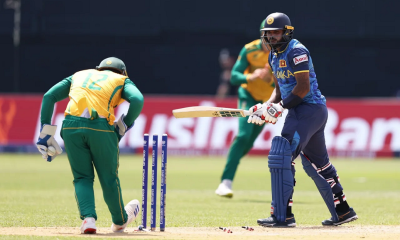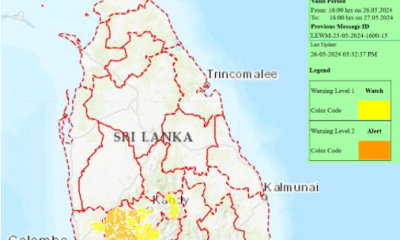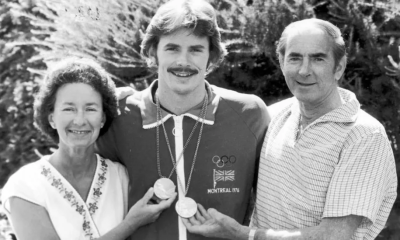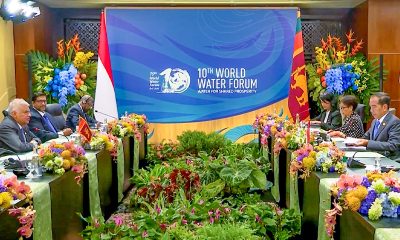Features
Back home working in Sri Lanka with WHO, ILO, World Bank and ICES

(Excerpted from Memories that linger: My journey through the world of disability by Padmani Mendis)
Although I had carried out assignments for all the WHO Regional Offices except the European Office quite early on in my journey, I had not really had the opportunity to work with WHO Colombo. That is until the year 2012 when the World Report on Disability was published jointly by WHO and the World Bank, a very significant event for disabled people worldwide. The Regional Office in New Delhi, for reasons best known to them, had selected Sri Lanka as a regional focal point for an official launch of the publication.
Dr. Lanka Dissanayake was handling the subject of disability in WHO Colombo and helped coordinate the event. Responsibility was shared by the Ministries of Social Services and that of Health. It was obvious to anyone that on this occasion the former held the floor. Disability was theirs and theirs alone. So clear they made it, that the Minister of Health left it to his deputy to attend the event. His position, it seemed, had been insulted. Such was the hierarchy.
Dr. Tom Shakespeare, one of the key figures behind the prestigious World Report, came from the UK to represent WHO and the World Bank. The launch was quite an affair. As is usual with the Ministry an exhibition of products made by disabled people was organised as well as a concert by them. A committee of six members from both ministries was set up to oversee arrangements. Dr. Dissanayake brought me into the committee. My task was to accompany Tom Shakespeare on a programme of visits she arranged for him. But she brought me in really because beyond the launch, she had another activity in mind.
And this is how she got the activity going. She took the opportunity of the launch of the publication to suggest to the two ministries that they launch at the same time the preparation of a National Plan of Action for Disability. This was later called the NAPD. The two ministries had naught to do but work with each other. To see the activity through she gave me an official position as a Consultant to work with the two ministries.
With the relevant officials, we brought together disabled people and others with expertise in various areas in particular groups to prepare the eight sections of the plan. These were based on the National Policy on Disability, NPD. My task, as well as providing advice, was the preparation of the written edited document based on the drafts submitted by the groups.
Much was achieved this way until it was time for an open forum. This was held with the participation of over 200 people. I have not to this day seen that many disabled people participate together with others at such an event in Sri Lanka.
The process did not end there. We followed through using the email to circulate the draft document as widely as possible. Feedback obtained was fed in until the draft was as complete as it could be. I estimated quite roughly that well over 600 people had participated in the preparation of that document.
Approved by the two ministries, it was submitted to cabinet by the Minister of Social Welfare. The formal document in the three languages has on its cover both ministries as co-producers. And a decade after our National Policy on Disability had been approved, we now had in 2014 a National Plan for its implementation.
How I wish that I could say that these documents were put into effect by government. No, that was never formally done. But one can still have some sense of satisfaction that much of the statements in the National Policy and strategies in the National Action Plan have even to some small extent been disseminated within and have pervaded our society. This is to be credited to concerned individuals and organisations, including academia dedicated to improving the situation of our disabled people over these many years.
It may also be that it was a result of these efforts as well as others that a consciousness grew in our society about the situation of our disabled people. And consequently, a consciousness also of their rights. And of what appeared to be associating disability with rights in the increasing public discourse and national dialogue. But no, not yet a major concern within government.
Following these few small steps, many hoped finally that Sri Lanka had taken a leap in 2016. This was when our country finally ratified the UN Convention on the Rights of Persons with Disabilities or CRPD, on February 8 of that year. Nope. No action to follow. False alarm again. Our government was likely responding to outside pressure that this had to be done. The enabling legislation for the CRPD is, just to remind you, still in the pipeline. The mechanism for its implementation has never been given a thought.
Nonetheless the two National Human Rights Action Plans (NHRAPs) that were made at around this time included disabled people as a subject area. I participated in the preparation of the NHRAP 2012 – 2016. It had been decided that disability was to be a cross-cutting issue in this plan and I was invited to serve on the relevant drafting committees.
By the time NHRAP 2017 – 2021 was being prepared, Sri Lanka had approved the CRPD so Disability had a whole section to itself. Here I was appointed to the drafting committee of the Disability section. Both remained as documents prepared using expensive paper with a glossy cover.
The whole fiasco led one to believe the NHRAPs were made only to impress the international community. Or to respond to their vociferous requests for Sri Lanka to fulfil our international commitments.
Journeying with the International Labour Organisation, Colombo
Journeying with the ILO in Colombo took me into a completely new ethos. Work, employment and the right to an income that was not connected with Community Based Rehabilitation (CBR). The right to work is the area in which perhaps the rights of disabled adults are most violated. Just as for children the greatest violation would undoubtedly be the right to education.
The most interesting of the tasks I did for ILO was in the Factory Improvement Programme implemented by the EFC or Employers Federation of Ceylon. It was therefore called the ILO – EFC Factory Improvement Programme.
This was an ILO regional programme aimed at improving the overall efficiency levels and competitiveness of selected factories. Including disabled people in these factories was part of the programme. A manual for training factory managers to fulfil programme aims was being developed by ILO.
My task was to field test the module in the manual which dealt with the inclusion of disabled people. I was first required to visit 10 factories in the western province selected for the field test and motivate employers to include disabled people in their workplace. Most were garment industries, while a few were related to the tea trade. It was a first experience for me going inside these factories and meeting staff. The factories were exceptionally well maintained as were their gardens, usually landscaped. All very pleasant.
I was most surprised by this finding. That is, nine of the 10 factories already had disabled employees. Speaking with them, I found that these employees were quite content with their situation. The managers, it appeared needed no motivating from me. This finding did not quite match the situation we found on the ground. The National Census of 2012 indicated that unemployment among disabled people was over 70%. Field workers believe it is even higher.
Beyond this was another welcome finding. While I was on the floor of a certain garment factory with the factory manager, the bell rang announcing the tea break. All the workers on the floor left as if in a hurry to make the most of the free time they were given. Except for one young man who waited to look around him; he went up to a colleague’s machine, did something with it and then left.
The manager explained to me what it was about. The young man, let’s call him Nanda, looked around him to see if all was in order. He found that a colleague had failed to switch his machine off, and this is what Nanda did before leaving the floor. The manager went on to tell me that Nanda had, the previous year, been recognised as the “Best Employee”. Nanda was deaf. He communicated with his colleagues using gestures and signs they made up. His impairment was no barrier at this workplace.
At yet another factory, the manager was proud to show me around so I could see how he had integrated in his factory more than a dozen disabled employees. He went on to say to me “If you bring me 20 disabled people tomorrow, I will give them all work.” And who talks of the low productivity levels of these our people?
The World Bank
Two of the more interesting tasks I did for The World Bank I would like to share with you. They were quite different from each other. The first took me in 2009 to many parts of my country again talking with many people from many different walks of life and a variety of institutions. This learning and experience went into a comprehensive report I gave to The World Bank calling it “Disability in Sri Lanka”.
The first appointment I carried out for this task was with the Director-General of Labour. Before I entered the beautiful new building housing the Ministry and Department of Labour, I had a toss, fell flat on my face and injured my foot. It was awfully painful and I could see my foot swelling up immediately. Appointments with these people were hard to get so I went ahead with it. It was later when I got to a hospital that I found out I had a fracture. My foot was put in a plaster cast. It could not take any weight for six weeks.
And so I started using a wheelchair. And this I used until I had completed the task travelling to all parts of the island for my work. Accessible hotels were very hard to find. Many buildings and offices were inaccessible. But people were kind. Even top Government officials came down to earth to meet me, some down from their Ivory Towers.
For the second task of preparing a document, I worked with the Ministry of Health, disabled people and a few others. This was approved and published by the ministry as their rehabilitation policy in 2014 and called “National Guidelines for Rehabilitation Services in Sri Lanka”. The process of preparing it involving discussions with a wide range of health personnel seemed to make them conscious to some degree of the needs of disabled people.
ICES and the Disability Policy Brief
The last formal work I carried out on my journey was with the International Centre for Ethnic Studies, ICES. The ICES was popular in our world because of the interest it showed in disability. Dr. Mario Gomes, the Executive Director, could very easily be approached by both disabled people and by us disability workers for particular support that we needed. So over the years, many meetings and workshops were sponsored and some research conducted related to disability.
Disability by this time had moved out of the public discourse. Action on it seemed to be low-key. Binendri Perera, an attorney attached to the University of Colombo and I discussed with Dr. Gomes the possibility of preparing for publication a brief document that may help to change this situation. The outcome of this is the ICES publication “Disability Policy Brief for Law Makers, Administrators and Other Decision Makers” in all three languages.
What Binendri and I did was synthesise in the document in point form the National Policy and National Action Plan both of which had Cabinet approval and the UN Convention on Disability which Sri Lanka had ratified.
To do this we analysed each recommendation and put them into one chart so that they could be related to each other and compared. This we trusted would lead to a comprehensive approach to implementation. We believed this simple format would encourage users to understand their respective roles in the overall process and take whatever action they could. ICES made sure it was distributed to reach all districts in Sri Lanka and divisions within many of those districts. One last attempt to move closer to a better life for our disabled people.
End of travel, but not of The Journey
I started my Journey in the World of Disability here at home in my Sri Lanka. I have shared with you the first small step of my journey that I took while yet at school with my decision to be a physiotherapist. And with that first step, the next to proceed to the UK to be an Orthopaedic Nurse as a means of studying to be a Physiotherapist.
It was right at the start of the five years and more of learning this process took that I made my contacts with disabled people of all ages. First as their nurse, to many their friend and confidante. Space permits me to share with you my experiences with only a few individuals of the many thousands that impacted my life as it was to unfold.
The first was but a small step, but one that led to all the steps I have taken since, taken during the next 65 years of my life to the age of 83 where I am now, back home where I started. Sharing my memories with you.
During the 64 years that I journeyed, unending opportunities made for me a journey that criss-crossed continents. When asked about it I have said that “I travel horizontally”. Because whilst I was in South America and the Caribbean during the early years, the rest of my journey I have spent in Asia, Africa and much of it in between, in the Middle-East. To me that is more important than the journeys I made North-South, although to participate in the many conferences, meetings and workshops in the industrialised north was also rewarding, as much as it was in the countries of the global south. And, of course, to share my learning through the innumerable teaching opportunities in many of the same countries.
Since about six years or so ago, physical impairment and difficulties have ended travel for me. But my journey is not ended. This continues in the Realm of Disability to this day. Modern communication technology makes it possible to meet North to South and East to West. Skype and Zoom and the good old telephone itself are a boon. My same dining table still serves as a conference table when I sit with the many visitors who come to talk with me about the situation of disabled people in Sri Lanka and elsewhere, past and present.
To share with you how my journey continues as of now here at home are just two examples. Last week I was interviewed by a Master’s student named Nathaniel from Columbia University in New York. About certain aspects of disability in Sri Lanka. But our discussion and my sharing also brought into it an international perspective. He was involved in a multi-country research study related to inclusive adolescent health care, the Report of which will be presented to a UN agency.
The second, a few months ago I was interviewed by Taryn from Mc Gill University in Montreal, Canada, also on zoom. She was carrying out a study related to women activists in Sri Lanka. I told her I did not consider myself to be an activist. But her definition being what it was she could not accept my reasons for that, and we had a really interesting discussion. Which came to be focused on my global journey in disability as it impacted my work in Sri Lanka.
And with that, it is time now to move on. To move on and reflect on my life as I lived it and on these the memories I shared with you.
Features
The heart-friendly health minister

by Dr Gotabhya Ranasinghe
Senior Consultant Cardiologist
National Hospital Sri Lanka
When we sought a meeting with Hon Dr. Ramesh Pathirana, Minister of Health, he graciously cleared his busy schedule to accommodate us. Renowned for his attentive listening and deep understanding, Minister Pathirana is dedicated to advancing the health sector. His openness and transparency exemplify the qualities of an exemplary politician and minister.
Dr. Palitha Mahipala, the current Health Secretary, demonstrates both commendable enthusiasm and unwavering support. This combination of attributes makes him a highly compatible colleague for the esteemed Minister of Health.
Our discussion centered on a project that has been in the works for the past 30 years, one that no other minister had managed to advance.
Minister Pathirana, however, recognized the project’s significance and its potential to revolutionize care for heart patients.
The project involves the construction of a state-of-the-art facility at the premises of the National Hospital Colombo. The project’s location within the premises of the National Hospital underscores its importance and relevance to the healthcare infrastructure of the nation.
This facility will include a cardiology building and a tertiary care center, equipped with the latest technology to handle and treat all types of heart-related conditions and surgeries.
Securing funding was a major milestone for this initiative. Minister Pathirana successfully obtained approval for a $40 billion loan from the Asian Development Bank. With the funding in place, the foundation stone is scheduled to be laid in September this year, and construction will begin in January 2025.
This project guarantees a consistent and uninterrupted supply of stents and related medications for heart patients. As a result, patients will have timely access to essential medical supplies during their treatment and recovery. By securing these critical resources, the project aims to enhance patient outcomes, minimize treatment delays, and maintain the highest standards of cardiac care.
Upon its fruition, this monumental building will serve as a beacon of hope and healing, symbolizing the unwavering dedication to improving patient outcomes and fostering a healthier society.We anticipate a future marked by significant progress and positive outcomes in Sri Lanka’s cardiovascular treatment landscape within the foreseeable timeframe.
Features
A LOVING TRIBUTE TO JESUIT FR. ALOYSIUS PIERIS ON HIS 90th BIRTHDAY

by Fr. Emmanuel Fernando, OMI
Jesuit Fr. Aloysius Pieris (affectionately called Fr. Aloy) celebrated his 90th birthday on April 9, 2024 and I, as the editor of our Oblate Journal, THE MISSIONARY OBLATE had gone to press by that time. Immediately I decided to publish an article, appreciating the untiring selfless services he continues to offer for inter-Faith dialogue, the renewal of the Catholic Church, his concern for the poor and the suffering Sri Lankan masses and to me, the present writer.
It was in 1988, when I was appointed Director of the Oblate Scholastics at Ampitiya by the then Oblate Provincial Fr. Anselm Silva, that I came to know Fr. Aloy more closely. Knowing well his expertise in matters spiritual, theological, Indological and pastoral, and with the collaborative spirit of my companion-formators, our Oblate Scholastics were sent to Tulana, the Research and Encounter Centre, Kelaniya, of which he is the Founder-Director, for ‘exposure-programmes’ on matters spiritual, biblical, theological and pastoral. Some of these dimensions according to my view and that of my companion-formators, were not available at the National Seminary, Ampitiya.
Ever since that time, our Oblate formators/ accompaniers at the Oblate Scholasticate, Ampitiya , have continued to send our Oblate Scholastics to Tulana Centre for deepening their insights and convictions regarding matters needed to serve the people in today’s context. Fr. Aloy also had tried very enthusiastically with the Oblate team headed by Frs. Oswald Firth and Clement Waidyasekara to begin a Theologate, directed by the Religious Congregations in Sri Lanka, for the contextual formation/ accompaniment of their members. It should very well be a desired goal of the Leaders / Provincials of the Religious Congregations.
Besides being a formator/accompanier at the Oblate Scholasticate, I was entrusted also with the task of editing and publishing our Oblate journal, ‘The Missionary Oblate’. To maintain the quality of the journal I continue to depend on Fr. Aloy for his thought-provoking and stimulating articles on Biblical Spirituality, Biblical Theology and Ecclesiology. I am very grateful to him for his generous assistance. Of late, his writings on renewal of the Church, initiated by Pope St. John XX111 and continued by Pope Francis through the Synodal path, published in our Oblate journal, enable our readers to focus their attention also on the needed renewal in the Catholic Church in Sri Lanka. Fr. Aloy appreciated very much the Synodal path adopted by the Jesuit Pope Francis for the renewal of the Church, rooted very much on prayerful discernment. In my Religious and presbyteral life, Fr.Aloy continues to be my spiritual animator / guide and ongoing formator / acccompanier.
Fr. Aloysius Pieris, BA Hons (Lond), LPh (SHC, India), STL (PFT, Naples), PhD (SLU/VC), ThD (Tilburg), D.Ltt (KU), has been one of the eminent Asian theologians well recognized internationally and one who has lectured and held visiting chairs in many universities both in the West and in the East. Many members of Religious Congregations from Asian countries have benefited from his lectures and guidance in the East Asian Pastoral Institute (EAPI) in Manila, Philippines. He had been a Theologian consulted by the Federation of Asian Bishops’ Conferences for many years. During his professorship at the Gregorian University in Rome, he was called to be a member of a special group of advisers on other religions consulted by Pope Paul VI.
Fr. Aloy is the author of more than 30 books and well over 500 Research Papers. Some of his books and articles have been translated and published in several countries. Among those books, one can find the following: 1) The Genesis of an Asian Theology of Liberation (An Autobiographical Excursus on the Art of Theologising in Asia, 2) An Asian Theology of Liberation, 3) Providential Timeliness of Vatican 11 (a long-overdue halt to a scandalous millennium, 4) Give Vatican 11 a chance, 5) Leadership in the Church, 6) Relishing our faith in working for justice (Themes for study and discussion), 7) A Message meant mainly, not exclusively for Jesuits (Background information necessary for helping Francis renew the Church), 8) Lent in Lanka (Reflections and Resolutions, 9) Love meets wisdom (A Christian Experience of Buddhism, 10) Fire and Water 11) God’s Reign for God’s poor, 12) Our Unhiddden Agenda (How we Jesuits work, pray and form our men). He is also the Editor of two journals, Vagdevi, Journal of Religious Reflection and Dialogue, New Series.
Fr. Aloy has a BA in Pali and Sanskrit from the University of London and a Ph.D in Buddhist Philosophy from the University of Sri Lankan, Vidyodaya Campus. On Nov. 23, 2019, he was awarded the prestigious honorary Doctorate of Literature (D.Litt) by the Chancellor of the University of Kelaniya, the Most Venerable Welamitiyawe Dharmakirthi Sri Kusala Dhamma Thera.
Fr. Aloy continues to be a promoter of Gospel values and virtues. Justice as a constitutive dimension of love and social concern for the downtrodden masses are very much noted in his life and work. He had very much appreciated the commitment of the late Fr. Joseph (Joe) Fernando, the National Director of the Social and Economic Centre (SEDEC) for the poor.
In Sri Lanka, a few religious Congregations – the Good Shepherd Sisters, the Christian Brothers, the Marist Brothers and the Oblates – have invited him to animate their members especially during their Provincial Congresses, Chapters and International Conferences. The mainline Christian Churches also have sought his advice and followed his seminars. I, for one, regret very much, that the Sri Lankan authorities of the Catholic Church –today’s Hierarchy—- have not sought Fr.
Aloy’s expertise for the renewal of the Catholic Church in Sri Lanka and thus have not benefited from the immense store of wisdom and insight that he can offer to our local Church while the Sri Lankan bishops who governed the Catholic church in the immediate aftermath of the Second Vatican Council (Edmund Fernando OMI, Anthony de Saram, Leo Nanayakkara OSB, Frank Marcus Fernando, Paul Perera,) visited him and consulted him on many matters. Among the Tamil Bishops, Bishop Rayappu Joseph was keeping close contact with him and Bishop J. Deogupillai hosted him and his team visiting him after the horrible Black July massacre of Tamils.
Features
A fairy tale, success or debacle

Sri Lanka-Singapore Free Trade Agreement
By Gomi Senadhira
senadhiragomi@gmail.com
“You might tell fairy tales, but the progress of a country cannot be achieved through such narratives. A country cannot be developed by making false promises. The country moved backward because of the electoral promises made by political parties throughout time. We have witnessed that the ultimate result of this is the country becoming bankrupt. Unfortunately, many segments of the population have not come to realize this yet.” – President Ranil Wickremesinghe, 2024 Budget speech
Any Sri Lankan would agree with the above words of President Wickremesinghe on the false promises our politicians and officials make and the fairy tales they narrate which bankrupted this country. So, to understand this, let’s look at one such fairy tale with lots of false promises; Ranil Wickremesinghe’s greatest achievement in the area of international trade and investment promotion during the Yahapalana period, Sri Lanka-Singapore Free Trade Agreement (SLSFTA).
It is appropriate and timely to do it now as Finance Minister Wickremesinghe has just presented to parliament a bill on the National Policy on Economic Transformation which includes the establishment of an Office for International Trade and the Sri Lanka Institute of Economics and International Trade.
Was SLSFTA a “Cleverly negotiated Free Trade Agreement” as stated by the (former) Minister of Development Strategies and International Trade Malik Samarawickrama during the Parliamentary Debate on the SLSFTA in July 2018, or a colossal blunder covered up with lies, false promises, and fairy tales? After SLSFTA was signed there were a number of fairy tales published on this agreement by the Ministry of Development Strategies and International, Institute of Policy Studies, and others.
However, for this article, I would like to limit my comments to the speech by Minister Samarawickrama during the Parliamentary Debate, and the two most important areas in the agreement which were covered up with lies, fairy tales, and false promises, namely: revenue loss for Sri Lanka and Investment from Singapore. On the other important area, “Waste products dumping” I do not want to comment here as I have written extensively on the issue.
1. The revenue loss
During the Parliamentary Debate in July 2018, Minister Samarawickrama stated “…. let me reiterate that this FTA with Singapore has been very cleverly negotiated by us…. The liberalisation programme under this FTA has been carefully designed to have the least impact on domestic industry and revenue collection. We have included all revenue sensitive items in the negative list of items which will not be subject to removal of tariff. Therefore, 97.8% revenue from Customs duty is protected. Our tariff liberalisation will take place over a period of 12-15 years! In fact, the revenue earned through tariffs on goods imported from Singapore last year was Rs. 35 billion.
The revenue loss for over the next 15 years due to the FTA is only Rs. 733 million– which when annualised, on average, is just Rs. 51 million. That is just 0.14% per year! So anyone who claims the Singapore FTA causes revenue loss to the Government cannot do basic arithmetic! Mr. Speaker, in conclusion, I call on my fellow members of this House – don’t mislead the public with baseless criticism that is not grounded in facts. Don’t look at petty politics and use these issues for your own political survival.”
I was surprised to read the minister’s speech because an article published in January 2018 in “The Straits Times“, based on information released by the Singaporean Negotiators stated, “…. With the FTA, tariff savings for Singapore exports are estimated to hit $10 million annually“.
As the annual tariff savings (that is the revenue loss for Sri Lanka) calculated by the Singaporean Negotiators, Singaporean $ 10 million (Sri Lankan rupees 1,200 million in 2018) was way above the rupees’ 733 million revenue loss for 15 years estimated by the Sri Lankan negotiators, it was clear to any observer that one of the parties to the agreement had not done the basic arithmetic!
Six years later, according to a report published by “The Morning” newspaper, speaking at the Committee on Public Finance (COPF) on 7th May 2024, Mr Samarawickrama’s chief trade negotiator K.J. Weerasinghehad had admitted “…. that forecasted revenue loss for the Government of Sri Lanka through the Singapore FTA is Rs. 450 million in 2023 and Rs. 1.3 billion in 2024.”
If these numbers are correct, as tariff liberalisation under the SLSFTA has just started, we will pass Rs 2 billion very soon. Then, the question is how Sri Lanka’s trade negotiators made such a colossal blunder. Didn’t they do their basic arithmetic? If they didn’t know how to do basic arithmetic they should have at least done their basic readings. For example, the headline of the article published in The Straits Times in January 2018 was “Singapore, Sri Lanka sign FTA, annual savings of $10m expected”.
Anyway, as Sri Lanka’s chief negotiator reiterated at the COPF meeting that “…. since 99% of the tariffs in Singapore have zero rates of duty, Sri Lanka has agreed on 80% tariff liberalisation over a period of 15 years while expecting Singapore investments to address the imbalance in trade,” let’s turn towards investment.
Investment from Singapore
In July 2018, speaking during the Parliamentary Debate on the FTA this is what Minister Malik Samarawickrama stated on investment from Singapore, “Already, thanks to this FTA, in just the past two-and-a-half months since the agreement came into effect we have received a proposal from Singapore for investment amounting to $ 14.8 billion in an oil refinery for export of petroleum products. In addition, we have proposals for a steel manufacturing plant for exports ($ 1 billion investment), flour milling plant ($ 50 million), sugar refinery ($ 200 million). This adds up to more than $ 16.05 billion in the pipeline on these projects alone.
And all of these projects will create thousands of more jobs for our people. In principle approval has already been granted by the BOI and the investors are awaiting the release of land the environmental approvals to commence the project.
I request the Opposition and those with vested interests to change their narrow-minded thinking and join us to develop our country. We must always look at what is best for the whole community, not just the few who may oppose. We owe it to our people to courageously take decisions that will change their lives for the better.”
According to the media report I quoted earlier, speaking at the Committee on Public Finance (COPF) Chief Negotiator Weerasinghe has admitted that Sri Lanka was not happy with overall Singapore investments that have come in the past few years in return for the trade liberalisation under the Singapore-Sri Lanka Free Trade Agreement. He has added that between 2021 and 2023 the total investment from Singapore had been around $162 million!
What happened to those projects worth $16 billion negotiated, thanks to the SLSFTA, in just the two-and-a-half months after the agreement came into effect and approved by the BOI? I do not know about the steel manufacturing plant for exports ($ 1 billion investment), flour milling plant ($ 50 million) and sugar refinery ($ 200 million).
However, story of the multibillion-dollar investment in the Petroleum Refinery unfolded in a manner that would qualify it as the best fairy tale with false promises presented by our politicians and the officials, prior to 2019 elections.
Though many Sri Lankans got to know, through the media which repeatedly highlighted a plethora of issues surrounding the project and the questionable credentials of the Singaporean investor, the construction work on the Mirrijiwela Oil Refinery along with the cement factory began on the24th of March 2019 with a bang and Minister Ranil Wickremesinghe and his ministers along with the foreign and local dignitaries laid the foundation stones.
That was few months before the 2019 Presidential elections. Inaugurating the construction work Prime Minister Ranil Wickremesinghe said the projects will create thousands of job opportunities in the area and surrounding districts.
The oil refinery, which was to be built over 200 acres of land, with the capacity to refine 200,000 barrels of crude oil per day, was to generate US$7 billion of exports and create 1,500 direct and 3,000 indirect jobs. The construction of the refinery was to be completed in 44 months. Four years later, in August 2023 the Cabinet of Ministers approved the proposal presented by President Ranil Wickremesinghe to cancel the agreement with the investors of the refinery as the project has not been implemented! Can they explain to the country how much money was wasted to produce that fairy tale?
It is obvious that the President, ministers, and officials had made huge blunders and had deliberately misled the public and the parliament on the revenue loss and potential investment from SLSFTA with fairy tales and false promises.
As the president himself said, a country cannot be developed by making false promises or with fairy tales and these false promises and fairy tales had bankrupted the country. “Unfortunately, many segments of the population have not come to realize this yet”.
(The writer, a specialist and an activist on trade and development issues . )
























